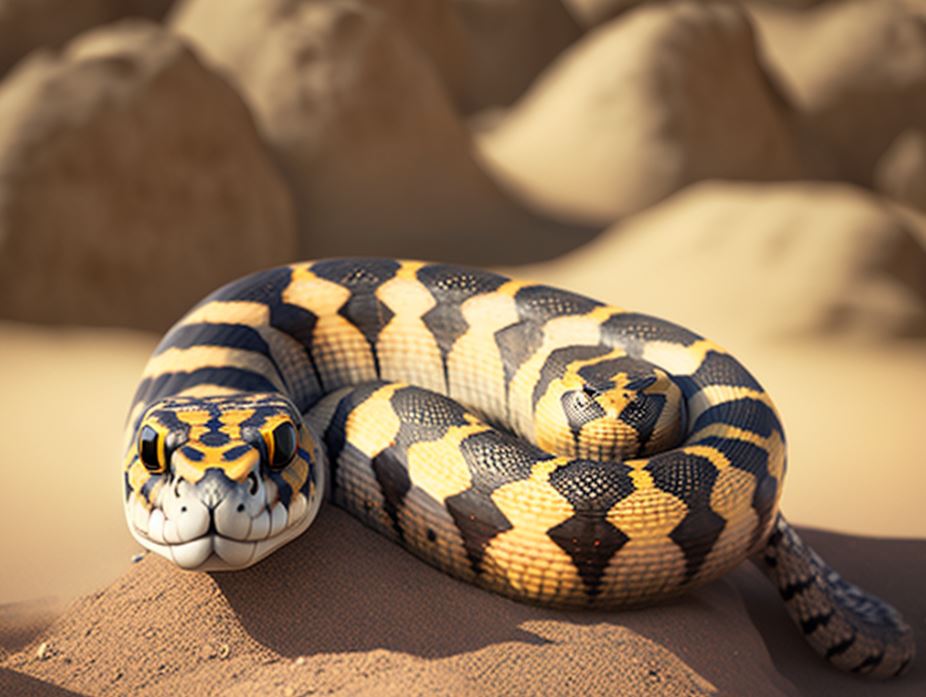10 Facts About Desert Kingsnakes |

|
|
Couldn't find a free photo of a desert kingsnake. Here's what AI decided to draw. |
Desert Kingsnakes are non-venomousDesert kingsnakes are non-venomous snakes, which means they do not produce any toxic substances. These snakes rely on constriction to subdue their prey, which they then swallow whole. They are often confused with venomous coral snakes, but you can easily tell the difference by looking at their color pattern. We talked about them on our podcast! Take a listen. They have an interesting defense mechanismDesert kingsnakes have a unique way of defending themselves from predators. When threatened, they will release a foul-smelling musk from their anal glands, which is often enough to deter predators. They may also vibrate their tail rapidly, making a sound similar to a rattlesnake, which can further discourage predators. Desert kingsnakes are opportunistic feedersDesert kingsnakes are opportunistic feeders, which means they will eat whatever prey is available. They feed on a variety of animals, including lizards, rodents, birds, and other snakes. They have even been known to eat venomous snakes such as rattlesnakes. They are excellent climbersDesert kingsnakes are excellent climbers and can climb trees and bushes with ease. They use their strong muscles and scales to grip onto branches and trunks, which allows them to reach their prey or find a safe spot to hide. They have a unique hunting styleDesert kingsnakes have a unique hunting style. They are known to actively hunt during the day, which is unusual for most snakes. They also use their keen sense of smell to locate prey, which they then ambush and subdue with their powerful constriction. Desert kingsnakes have a distinct colorationDesert kingsnakes have a distinctive coloration that sets them apart from other snakes. They have a black and white banded pattern that resembles the venomous coral snake. However, unlike the coral snake, the bands on the kingsnake are in a different order, making it easy to tell the difference. They are excellent swimmersDesert kingsnakes are excellent swimmers and are often found near water sources such as rivers and streams. They use their long and slender bodies to propel themselves through the water, and can even stay underwater for several minutes. They hibernate during the winterDesert kingsnakes are cold-blooded, which means their body temperature is regulated by their environment. During the winter months, when temperatures drop, they will hibernate in underground burrows or other sheltered areas until the weather warms up again. They have a long lifespanDesert kingsnakes have a relatively long lifespan, with some individuals living up to 20 years in the wild. However, their lifespan can be shorter in captivity due to factors such as diet and living conditions. They are important to the ecosystemDesert kingsnakes play an important role in the ecosystem as both predator and prey. They help to control populations of rodents and other small animals, which can prevent overgrazing and other ecological problems. In turn, they are preyed upon by a variety of animals, including birds of prey, coyotes, and other snakes. This helps to maintain a balance in the food chain and ensures that the ecosystem remains healthy. Final thoughts on the Desert KingsnakeDesert kingsnakes are fascinating creatures that have adapted well to the harsh desert environments of the southwestern United States and Mexico. They are non-venomous, opportunistic feeders, excellent climbers and swimmers, and play an important role in the ecosystem. By learning more about these amazing snakes, we can better appreciate the unique and fragile ecosystems in which they live. Want More Great Animal Facts?We have plenty of great animal fun facts on our website! Check out some more right now. Desert Kingsnake FAQsAre desert kingsnakes dangerous to humans?No, desert kingsnakes are non-venomous and are not considered dangerous to humans. However, like all snakes, they should be treated with respect and left alone in the wild. What is the best way to observe desert kingsnakes in the wild?Desert kingsnakes are generally active during the day, so the best way to observe them is to go out during the early morning or late afternoon hours when they are most active. Look for them in rocky areas or near water sources. Do desert kingsnakes make good pets?Desert kingsnakes can make good pets for experienced snake keepers. However, they require a specialized diet and environment, and can be difficult to care for properly. |